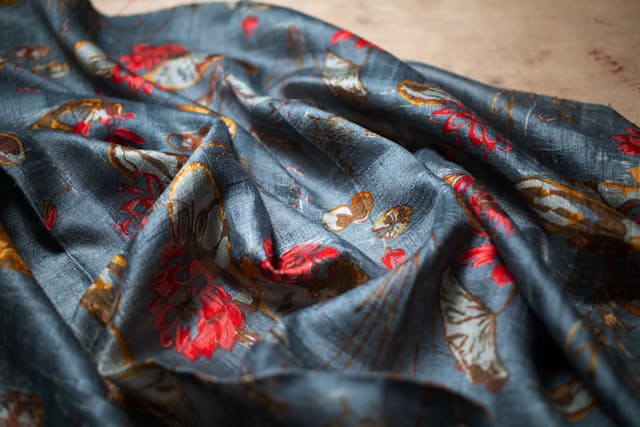
How is silk made? It is made from the cocoon of the silkworm.
Silk is a natural material that has been around for over 5 thousand years. Silk was first made by the Yangshao culture in China in the 4th millennium BC. One legend has it that an Empress was drinking tea and a silkworm cocoon fell into her cup. The silkworm tried to get out of the cup and the cocoon began to unravel and the empress wove the thread, creating silk. China was the only producer of silk for thousands of years and kept it secret. It was only in about 500 BC that it became a very important export. It was the reason the Silk Road was started, which was an opportunity for many other goods to be traded as well. Other countries wanted to have their own silk production and by about 300 AD, silk production had reached Japan, India, the Arab world, and the Byzantine Empire. Chinese silk became less necessary, but China was still the source of the world’s best silk. The crusades brought silk from the Middle East to Western Europe and demand shot up again. The Industrial Revolution had a big impact on silk because it made cotton less expensive, which lowered the demand for silk. It also improved methods for spinning and weaving silk, but demand was still lower than before. Cotton became a necessity and silk became a luxury. Today, most of the world’s silk is produced in China. They produce about 150,000 tons of silk every year. Incidentally, we have nylon because of silk. Silk production was carried to the New World and the United States became a large producer of silk. However, during World War 2, the USA was cut off from the rest of the world’s silk and they invented nylon as a synthetic replacement for it.
Silk is a very valuable material for many reasons. Firstly, it is very soft and light. Secondly, it shimmers because it reflects the light in ways that other materials don’t. Thirdly, it is very strong. It has the greatest tensile strength of any natural fiber. Fourthly, silk is a better insulator than cotton and will keep the wearer warm in the winter and cool in the summer. Lastly, if cared for properly, silk will last much longer than any other material.
So, what is silk? It is a natural protein fiber produced by the silkworm. There are many different kinds of silkworm, but the one most commonly used for silk production is the Bombyx mori, which is the domestic silk moth. Silkworms are the larvae stage of the silk moths. Silk moths lay eggs and the eggs take about 14 days to hatch. The larvae eat until they grow big enough to start their metamorphosis. They spin themselves a cocoon where they can change into their adult form, which is the moth. The cocoon that the larvae spin is the silk we use. When the larvae spin their cocoon, they produce a thread made of protein fiber from their salivary glands. The thread is covered in sericin, which is a glue-like substance that the larvae secrete to hold the silk thread together as they spin. It takes the larvae about three days to spin their cocoon and they make it out of one single thread. This thread is between 300 and 900 m long!
To make the silk, the first step has to be to kill the larvae inside the cocoon. This is done by heating them with steam or just by boiling them. The heat kills the larvae, and it loosens up the threads, weakening the sericin a little. Once that is done, the cocoon is brushed to free up the end of the thread and then it is spun so the cocoon unravels. The silk thread is spun with other threads to make yarn. It takes about 10,000 cocoons to make one silk sari and billions and billions of them are killed every year. It is possible to make silk without killing them. There are ethical silk brands that use the cocoon after the moth has left, but these don’t work on the mass scales that are needed to produce the world’s silk. When the moth leaves the cocoon, it produces a liquid that dissolves a hole in the cocoon. That means the whole cocoon is no longer one continuous thread and it takes more work to spin the smaller pieces together to make the yarn. It is much easier, although less ethical, to use the cocoon before the moth can leave. And this is what I learned today.
Photo by maadhuri g: https://www.pexels.com/photo/printed-piece-of-fabric-2933636/
Sources
https://sewport.com/fabrics-directory/silk-fabric
https://www.thelightshadestudio.co.uk/Useful-Info/History-of-Silk
https://en.wikipedia.org/wiki/Yangshao_culture
https://www.theindiansilkexportpromotioncouncil.com/history-of-indian-silk.php
https://www.chinahighlights.com/travelguide/culture/chinese-silk.htm
https://gingerlily.com/blogs/journal/cotton-vs-silk-which-is-the-better-fabric
https://en.wikipedia.org/wiki/Bombyx_mori
https://en.wikipedia.org/wiki/Silk
https://depts.washington.edu/chinaciv/clothing/tsericu.htm
https://www.wanderingsilk.org/ahimsa-silk-the-story
